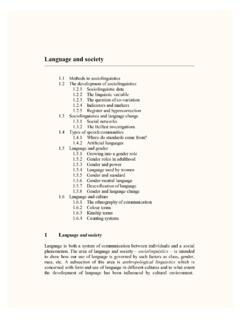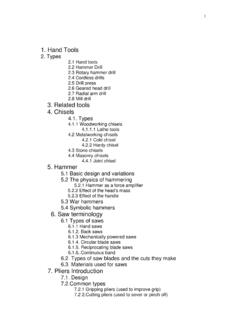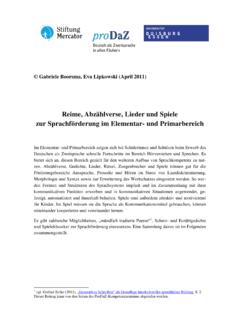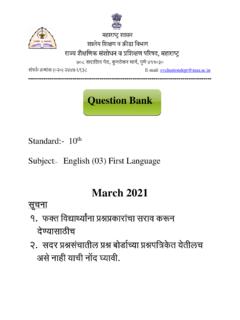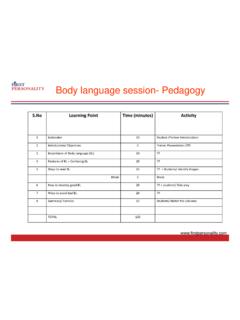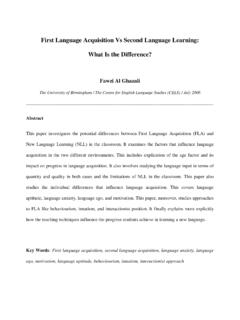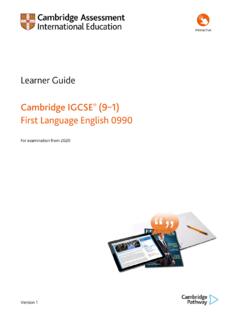Transcription of First and second language acquisition: A brief comparison
1 Raymond HickeyEnglish LinguisticsCampus EssenFirst and second language acquisition: A brief comparisonFirst language acquisitionSecond language acquisitionAn instinct, triggered by birthA personal choice, required motivationVery rapidVaries, but never as quick as FLAC ompleteNever as good as a native speaker, thoughgood competence can be achievedNatural (no instruction)Natural or guided (for synthetic languagesgrammatical instruction is requiredNote the following facts concerning First and second language acquisition1) The level of competence acquired with SLA ( second language acquisition) depends notso much on the time spent learning a language as the time at which one ) In general linguists maintain that a First language is acquired, that knowledge is storedunconsciously, and that a second language is learned, that knowledge is gained byconscious study of the second language s structure.
2 However, this distinction is notwatertight and SLA can involve acquisition to a certain degree. FLA ( First languageacquisition) does not, however, learned as no instruction is required. Remember that youknow your First language before you start ) There is a critical period, that of puberty, around 12 or 13 years of age, after which it isdifficult, if not impossible to acquire a second language with the same degree ofcompetence as the First language . The decline in ability to acquire a second language mayalso be connected with the lateralisation of the brain just before puberty, with thefixing of functions in one or other of the two halves of the brain.
3 The decline inacquisitional ability after lateralisation/puberty is a widespread phenomenon and affectsother activities such as sports, playing music, ) Because SLA is very largely conscious it is dependent on factors such as motivation andpersonality. This does not apply to FLA which is triggered by birth, it is an instinct inthe biological sense of the word. Remember that no-one ever refuses to acquire one sfirst language and that no-one dislikes one s own First language . Because FLA is aninstinct there is no choice involved, contrast this with a second ) Note that something which is acquired does not require conscious decisions whenactivated. However, if you have learned something, like the rule of chess then you mustRaymond Hickey First and second language acquisition: A brief comparison Page2 of 2think consciously about how to move the pieces.
4 An unconscious activity, apart fromlanguage, acquired in childhood would, for instance, be the ability to ride a bicycle. 6) Your First language is acquired without too much input from your , this input does not have to be ordered: children make sense of what theyhear and create the order needed to stored knowledge of their First language is not necessary to speak to young children in a babyish way: children do not end upspeaking like this ) First language acquisition is not dependent on intelligence or special ability forlanguages. Everyone acquires their native language fully and properly. What is true, ofcourse, is that some people have a greater stylistic range and larger vocabulary in theirnative language , but that is not connected with First language acquisition.
5 You learn stylein school when you learn how to write the standard of your language and you learnspecialised words consciously after ) First language acquisition is connected to cognitive development with the latterpreceding the former somewhat. With the second language (acquired after puberty) youhave all the cognitive structures necessary to deal with the ) You cannot forget your First language , although it may become inactive if you spend manyyears speaking just a second language . Backsliding, reverting to a lower level ofcompetence, making mistakes you know mistakes, are features of second languageacquisition ) There are certain phases in First language acquisition: one-word, two-word andmulti-word stages.
6 Furthermore, in early childhood children make maximally simplergeneralisations about language , that all verbs are weak. After a while they correctthemselves (when they just hear the adult forms). Once they have acquired the latter theyremember ) In FLA children make errors, systematic ill-formed structures based on the level ofacquisition on which they happen to be. In post-puberty SLA individuals make mistakeswhich are often random and erratic, though a degree of regularity can be recognised SLA there can be interference from the First language , structures from L1 arecarried over into L2 where they do not occur natively. Interference obviously does notoccur in ) FLA children build up competence, the internalised knowledge of one s native language ,from the performance of others, by accepting spoken input from those peoplesurrounding them.
7 The parents are obviously important here, but siblings and playmatescan play an equally important role if they are ) In the strict sense bilinguals are those individuals who have acquired two languagessimultaneously in early childhood. Normally, one of these languages will be dominant,but the degree of competence in the non-dominant language is still very high and farexceeds that of a second language learned after puberty.


